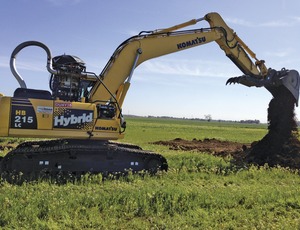

A two-year study of hybrid construction vehicles reveals that while the machines offer significant savings in fuel consumption and greenhouse-gas emissions, they produce higher levels of smog-forming pollutants than their conventional diesel counterparts. The results have come as a surprise to scientists, who say the machines will require further engineering to integrate their diesel-electric hybrid power trains and balance emissions.
The study demonstrates that diesel-electric hybrid heavy machinery is still in its infancy, scientists say. "The engine isn't really designed to be a hybrid yet," explains Kent Johnson, assistant research engineer at University of California, Riverside, and the project's main investigator. "It's unfortunate, because you are getting these great fuel economy benefits, but the emissions tend to be higher."
California's Air Resources Board (ARB) commissioned the $2-million study to calculate the benefit of diesel-electric hybrids, which became available to the U.S. market in 2009. But the machines arrived at a time when the U.S. Environmental Protection Agency was imposing stricter limits on off-road diesel engines. Indeed, the federal cuts continue: In January, EPA's Tier 4 Final standard, which calls for nitrogen-oxide (NOx) emissions to fall to near-zero levels, will kick in for most large machines. Manufacturers are using technologies such as selective catalytic reduction, which doses urea into the exhaust to neutralize NOx, a smog-forming gas.
Prior to the study, California provided nearly $1 million in vouchers to public and private fleets to help owners defray the cost of buying hybrid machines. Researchers then developed in-use tests to measure emissions on Caterpillar D7E hybrid dozers and Komatsu HB215-LC-1 hybrid excavators working on tasks that mimicked actual fieldwork. Scientists measured actual emissions and compared them against their conventional counterparts'. The study also predicted the effect of replacing conventional machines operating across the state with the hybrids.
Completed in April 2013, testing found, predictably, that fuel economy and emissions vary on application but confirmed the machines saved fuel overall. However, average NOx emissions measured higher overall than conventional diesels', a phenomenon that was not expected. Still, the NOx emissions did not exceed federal limits, researchers noted.
During the trials, the Caterpillar D7E saved an average of 14% in fuel and carbon-dioxide (CO) emissions, but nitrogen oxides were up 13%. The dozer, which was fitted with a Tier 4 Interim diesel engine, was compared to a conventional Caterpillar D6T dozer with the same size and class of diesel engine. Likewise, the Komatsu machine, on average, saved 16% in fuel and CO, while NOx emissions were up 1%. The Tier 3-equipped machine was pitted against a Komatsu PC200 conventional excavator. While Komatsu's machine uses an energy storage device, Cat's does not.
"This data suggests that the next generation of hybrid construction equipment will need additional technological advances to ensure it achieves substantial greenhouse-gas benefits while also delivering NOx emission reductions across all duty cycles," concludes ARB. That task is not expected to be difficult, says Daniel Sperling, a professor of engineering at the University of California, Davis, a member of ARB and co-author of "Two Billion Cars: Driving Toward Sustainability." With better integration, he says, "it is pretty easy to reduce NOx emissions."
The next steps are to repeat the study on new hybrid machines after the federal standards take full effect and expand tests to other hybrids, researchers say. Since the study began, more hybrids have become available, such as the Caterpillar 336EH excavator, a diesel-hydraulic hybrid, and the Deere 644K wheel loader, a diesel-electric hybrid. Both promise fuel savings of up to 25%. More are expected to be unveiled at the CONEXPO show next March in Las Vegas. Although early adopters say they enjoy hybrid fuel savings, some fleet owners tell ENR they are holding off on buying hybrids until the various technologies are sorted out.
Manufacturing sources say they are not surprised by the study's results and agree that hybrids require more fine-tuning. "The operation of a hydraulic excavator in various applications will return varied results on fuel economy and emissions," Komatsu says in a statement, adding that it is committed to further hybrid development. Caterpillar says in a statement that it chose not to participate in the California study and notes that the study "refers to the D7E as a hybrid, which it is not."


Post a comment to this article
Report Abusive Comment